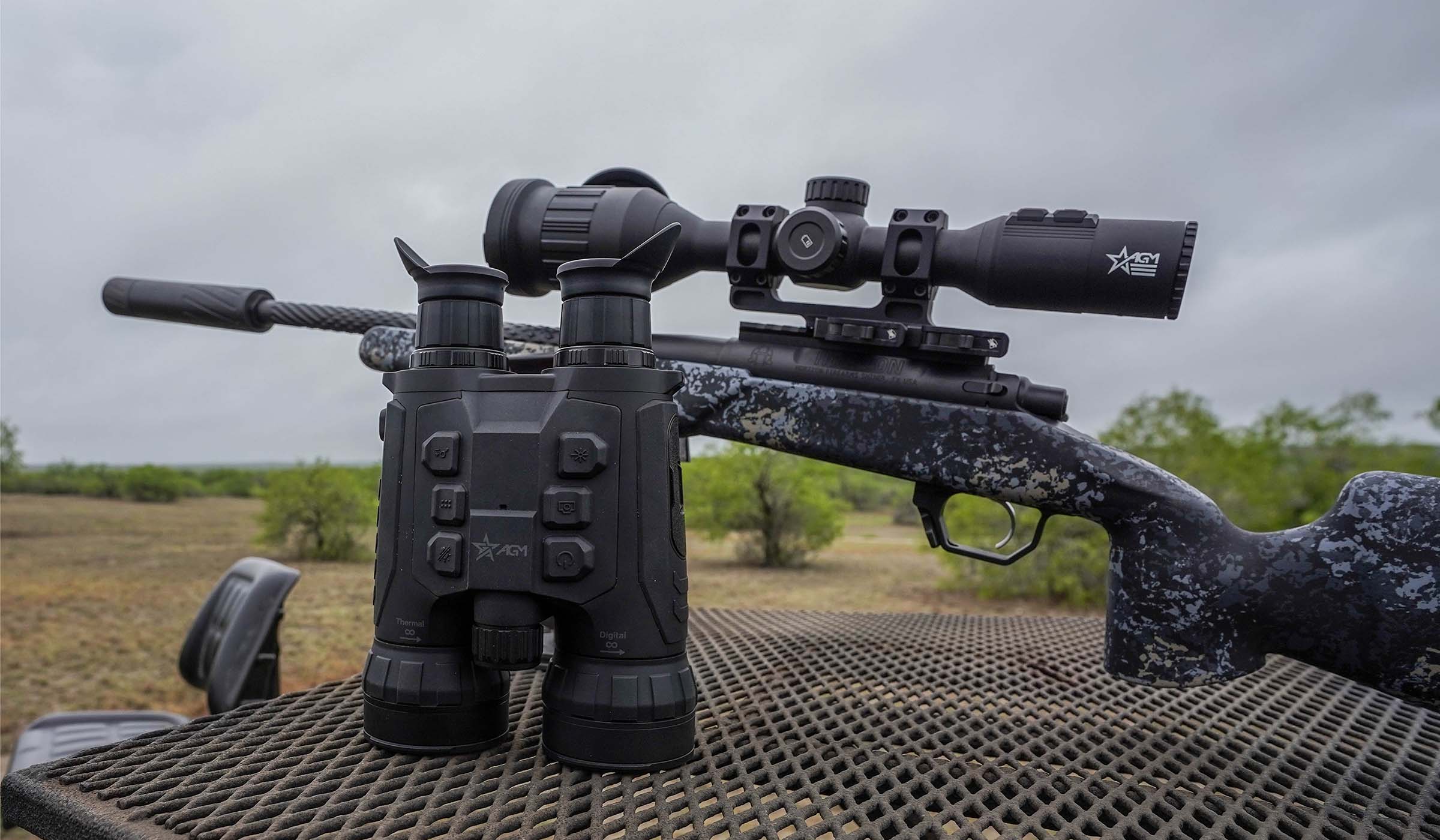We may earn revenue from the products available on this page and participate in affiliate programs. Learn More ›
Thermal monoculars and binoculars are among our most versatile night optics, and because they’re not tethered to a weapon, they certainly have many more use-cases than dedicated scopes. But the average price of a quality thermal viewer is around $3,000, so it’s not a casual purchase.
Which viewer is right for you? Do you want a high-end, high-resolution unit with a laser rangefinder and an on-board ballistic solver? Or do you want a lower-end unit just for detecting targets? Or can you get by with a simple viewer for close range observation, whether in your home or campsite? Do you need a binocular or a monocular?
Our test of the top thermal viewers of the year is designed to answer all those questions. We put a dozen viewers, most of them new for 2025, through the nocturnal paces on a ranch in South Texas, using them for predator and hog hunting, target shooting, and general observation. We evaluated their viewing talents, image capture and sharing, connectivity to mobile apps, and ability to adapt to changing conditions. That includes assessing their images at base magnification and then all the way up the magnification range.
These units run the gamut from under $400 up to $7,500, with performance generally in direct proportion to the price. The very best of these thermals will resolve the musculature of animals at night up to a quarter mile away. The worst will determine only that they’re warm globs. Some have on-board laser rangefinders, a key feature if you’re spotting for a designated shooter. Others, like the Vista monocular from Nocpix, communicate range and ballistics data directly to the linked scope of a shooter, making it an exceptionally useful partner for nighttime predator and hog hunting.
Happily, there’s a thermal viewer for every use case and budget. Here are the best thermal monoculars and binoculars we tested:
The Best Thermal Monoculars and Binoculars: Reviews and Recommendations
Editor’s Choice, Best Overall: Nocpix Vista H50R Thermal Monocular
Photo by Scott Einsmann
See It
Pros
- Communicates with other Nocpix devices through N-Link connection
- Extremely high-def display Image-stabilization feature calms images
- Sensitive and powerful laser rangefinder
- 5-plus hour run time
Cons
- Images are heavily filtered
- Viewing display is like looking down a narrow tube
Key Features
-
640×512 thermal sensor -
2560×2560 AMOLED display -
12-micrometer pixel pitch -
-
60Hz frame rate -
4x base magnification -
2,400-yard detection range -
1,200-yard thru-lens laser rangefinder -
64GB on-board image storage -
Price: $3,499
One of the surprises of the test was the overall satisfying performance of this sharp, bright, and reasonably priced 640-class monocular from what can best be called a new heritage brand (more on this below). The Vista H50R sits in the upper middle of the Vista family, sporting a very useful laser rangefinder and 50mm germanium objective lens but powered by a fairly standard 640×512 thermal sensor. Nocpix’s flagship Vista S50R contains the brand’s new and powerful 1280×1040 sensor but costs around $5,200.
The Vista H50R, with a 4x base magnification and 10-times zoom to 40x, surged to the front of the test lineup by doing a number of things extremely well, from precise ranging with its through-the-lens laser rangefinder, which keeps its form factor streamlined, to its easy connectivity to the very good Nocpix mobile app, to its easy-to-navigate menu.
A noteworthy detail is its vivid, high-resolution display, one of the best in the test. It’s a 2560×2560-pixel AMOLED display with industry-standard 12-micrometer pixel pitch, and its

The reason we described Nocpix as a “new heritage brand” in the intro is that it’s a new brand from Texas-based InfiRay Outdoor, which has been around the thermal business for years and whose former distributor, Yantai iRay Technology Co., is prohibited from doing business in the U.S.
This year Nocpix is pioneering a new device-to-device communication system, called N-Link, which operates like Sig’s BDX system, using wireless Bluetooth to transmit data from one device to another. In the case of the Vista monoculars, the rangefinder distance and any ballistics-adjusted aiming solution can be sent to a shooter with an N-Link-enabled scope. It’s an extremely handy system for a spotter-shooter team to reduce movement and confusion and become more effective night hunters.
The team also lauded Nocpix’s extremely readable, user-friendly manual, simple button and menu navigation, and in-hand balance. But it’s the image and display that elevated this monocular to our Editor’s Choice, though some testers noted that the amount of image enhancement, through filters and software, created significant eye strain after a few hours of continuous nighttime use.
“Excellent detail and detection,” noted tester Scott Einsmann. “I could easily identify steel targets out to 800 yards and deer at 150 yards had sharp detail.”
At about $3,500, it’s a serious investment, but the Vista H50R delivers all the detail, image sharpness, and hunter-friendly features of thermal viewers costing twice as much.
Best Thermal Binocular: AGM Global Vision ObservIR LRF 60-1280
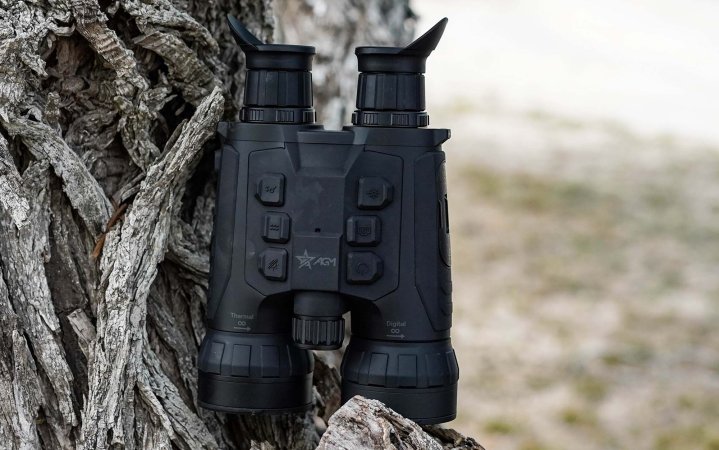
Photo by Scott Einsmann
Buy From EuroOptic
Buy From Optics Planet
Pros
- Best image quality in the category
- Dual-spectrum thermal and digital day/night system
- Impressive 8-hour run time on single charge
- Built-in 850nm IR illuminator
- Big 60mm germanium thermal lens
- Tripod adapter
Cons
- Buttons hard to navigate in heat of hunt
- Glitchy rangefinder
- Objective-lens focus hard to use
- At $7,500, wildly expensive
Key Features
-
1280×1024 thermal sensor -
1920×1080 OLED display -
3840×2160 optical resolution -
12-micrometer pixel pitch -
-
2.5x base magnification, 28x zoom -
25Hz refresh rate -
1,000-meter laser rangefinder -
Built-in GPS module and digital compass -
Price: $7,495
This is simply an astonishing optical device. Its best-in-class 1280×1024 sensor delivers thermal images so crisp and clear that testers could easily see rough details of deer at 1,000 yards, and at 250 yards we could see their eyelashes at night. The AGM ObservIR is also a capable daylight optic, its left barrel housing a digital channel that renders decent images in sunlight but also helps with target ID at night, working in tandem with the 60mm germanium thermal lens in the right barrel.
The binocular has all the attributes you’d expect from a high-end thermal: 64GB of on-board image storage, easy connectivity to a very good mobile app, picture-in-picture mode, hot-spot tracking, multiple color palettes, and a 1,000-meter laser rangefinder. It also boasts a powerful IR illuminator, which helps splash targets with light to power the digital (daylight) channel in Night or Auto modes. Its startup is quick, and it demonstrates very little freezing while the display refreshes.
Every tester, especially those of us trundling around on competitive coyote hunter David Stroud’s high-rack shooting platform, praised the ObservIR’s stabilized image, especially when panning landscapes.
“Amazing image quality, from contrast and colors to detail at distance,” notes tester Derrick Ratliff.
“By far the best image in this class,” added tester Alex Robinson.
Much of that image resolution is a product of AGM’s 1280×1024 thermal core, a new class of sensor that’s approximately double the resolution and sensitivity of the standard 640-pixel core. But AGM has added some fairy dust of algorithms and image treatment to its feed, creating almost 3D images and sharp contrast, as well as image stabilization in panning mode. One of the unfortunate byproducts of this digital magic is night-blindness after a long session behind the ObservIR.
The other drawback is the frustrating navigation of the overly complicated 6-button operation. We could easily riff between menu functions and capabilities when we had time and daylight, but in the heat of a coyote hunt, that’s simply too many buttons, and we flubbed opportunities at South Texas coyotes and bobcats because we were trying to work through the dizzying number of options powered by the buttons.
“Stupidly difficult to use,” snorted tester Scott Einsmann. “But, if these were your only thermal binos you could learn its operation with time.”
Testers also had trouble linking to the AGM mobile app, and only one or two testers managed to activate the laser rangefinder in the heat of the hunt. Those operational hiccups, combined with the stratospheric price, dinged the ObservIR on scoring.
AGM produces a 640-pixel version of the ObservIR (the ObservIR LRF 35-640), which retails for about $4,000. It’s a more attainable product, for sure, but lacks the stunning image resolution of its 1280-class superstar.
Most Innovative: Nocpix QUEST H35R Thermal Binocular

Photo by Scott Einsmann
Buy the H50R From Scheels
Buy From Optics Planet
Pros
- Best ergonomics of any thermal binocular
- 1,000-yard laser rangefinder detection range
- 64GB on-board image storage
- Ability to “hot-swap” batteries without shutting down device
- Ergonomic one-hand operation
- Independent zoom/focus controls
- At about $3,000, fairly priced
Cons
- Doesn’t connect to Nocpix’s N-Link system
- Underwhelming image quality
Key Features
-
640×512-pixel thermal core -
1920×1200 AMOLED display -
12-micrometer pixel pitch -
60Hz frame rate -
-
3x base magnification, 24x zoom -
Dual-battery operation -
Price:
$2,999
The problem with most thermal binoculars is that they’re not binoculars, at all. Rather they’re monoculars that happen to have an extra lens that contains the laser emitter and receiver for an on-board rangefinder.
Plus, thermal binoculars are clunky to use, often requiring users to turn a focus dial on the end of the objective lens to sharpen the image, an operation that causes these devices to shake and blur unless they’re mounted to a tripod.
The new QUEST H35R from Nocpix solves the shakiness by putting the focus control where you’d expect to find it on a conventional binocular, between the lenses in easy reach of fingertips. The QUEST still isn’t quite a binocular, since it has a single thermal lens, but it behaves like one, with the added benefit of focus and zoom controls on the same center-bridge rotary control. Smart. Fast. And easy to operate with either one or two hands.

Compared to the 60mm, 1280-class (and $7,500) AGM ObservIR binocular, the image delivered by the 35mm, 640-class ($3,000) Nocpix Quest is less bright and sharp. Setting aside image resolution, the Quest is the more usable device, with only four navigation buttons and that dual-function rotary dial that makes operation easy without memorizing the user manual. A more powerful 50mm version of the Quest, with a 2,600-meter detection range, is available for about $500 more than the 35mm version.
We’d like to see future configurations of the Quest equipped with Nocpix’s remarkable N-Link device-to-device communication, but for now the H35R version has good connectivity to a mobile app that facilitates easy image and video sharing. If you’re in the market for a mid-priced thermal binocular with easy operation, the Quest is a great pick.
Great Buy, Best Value: Guide TE211M
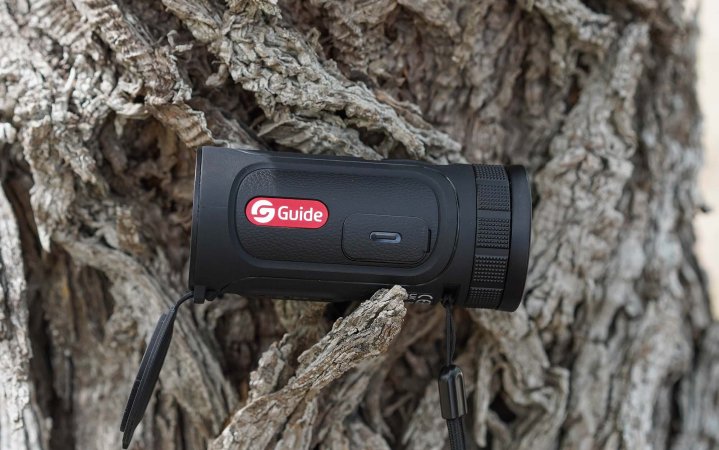
Photo by Scott Einsmann
See It
Pros
- Extremely compact, easily fits in pocket
- Menu functions accessed by rotating eyepiece collar
- Touch-screen display is intuitive and easy to manipulate
- Fixed focus
- At about $500, an affordable thermal viewer
- Extremely versatile
Cons
- Disappointing sensitivity and range
- Frequent power loss
- Stingy 10mm germanium lens limits performance
Key Features
-
256×192 thermal sensor -
466×466 AMOLED touch-screen display -
12-micrometer pixel pitch -
-
50Hz frame rate -
550-yard detection range -
16GB on-board image storage -
Internal rechargeable battery -
6-hour run time -
Tripod-mountable -
Price:
$500
This fun, useful, somewhat frivolous thermal viewer splits the difference between a toy and a serious hunting tool. On the fun side, it’s the most affordable and user-friendly thermal device in our test, running about $500 and employing a touch screen similar to your smartphone to easily navigate operation at night or when time is of the essence.
On the serious side, the image it delivers will benefit every hunter, whether you’re trying not to bump deer as you leave an evening bow stand, need to see what’s outside your tent (or house) at night, or want to scan a landscape out of curiosity or necessity.
Testers were split on whether this is a serious thermal device or a novelty, but I land on the former perspective. The compact, pocket-sized form factor allows it to go everywhere, and the decent 256×192-pixel thermal core is powerful enough to identify targets out to about 250 yards (the Belgian company that owns Guide claims a 550-yard detection range).
The attribute that constrains the Guide TE211M is the tiny 10mm germanium objective lens, which limits the resolution the thermal core can render to the human eye. In addition, the fixed focus limits useful sharpness to about 100 yards. But that’s plenty far for most purposes, and OL’s testers kept using the terms “fun,” “surprising,” and “super handy.”
Adding to its merits, the Guide TE211M has a 10-year warranty, 6-hour run time, and 16GB on-board image storage. At 111mm, about 30mm shorter than the length of your iPhone, the Guide fits in any pocket and goes anywhere. Serious fun.
Don’t buy this expecting to be wowed by its reach or resolution. But for an entry-level thermal that you’ll carry from the field to town, it’s a very handy device.
Best Under $400: Topdon TS004
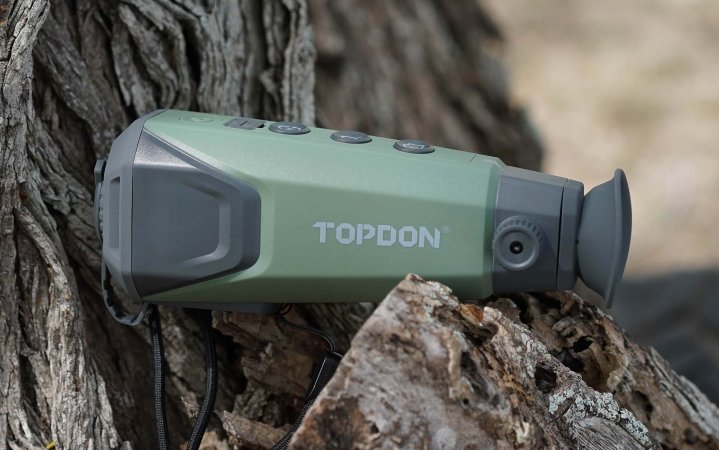
Photo by Scott Einsmann
See It
Pros
- Fingertip eyepiece focus
- Three-button operation
- 5 color palettes
- 10-hour run time
- At less than $400, an accessible price
Cons
- Fixed focus
- Puny 13mm germanium lens
- No app; transfer images via USB cable
Key Features
-
245×192 sensor -
12-micrometer pixel pitch -
640×480 LCOS display -
-
32GB on-board image storage -
1x base magnification -
Price:
$389
If you’re curious about the capabilities of thermal instruments but don’t want to invest several thousand dollars in a high-end viewer, this isn’t a bad way to break into the game. Topdon is better known for producing diagnostic tools and battery testers for the auto industry, but this entry into thermal viewers is a price-point unit that has decent close-range utility.
It is limited by its fixed focus; objects beyond about 100 yards are simply fuzzy warm blobs. It doesn’t have Wi-Fi or a companion mobile app. It stores up to 32GB of photos and videos on its onboard memory, but to transfer them to a phone or computer, you must connect a USB cable. The unit has a 1-year warranty, half of the industry standard, and the tiny 13mm objective lens further throttles its performance.
Given those limitations, you might be wondering why we rate the TS004 as the best entry-level unit. It’s because inside 100 yards, and certainly inside 50 yards, the little unit delivers good images. Think of it as a treestand thermal, or a household device to check on things that go bump downstairs in the night or to assess problematic wiring or leaky windows. It’s easy to use, with simple navigation and a decent number of features, and icons on the three navigation buttons tell you their function.
“I liked this price-point viewer more than I expected,” noted tester Alex Robinson. “The main issue is the lack of focus adjustment really limits its utility.”
But at under $400 (on some websites significantly under $400), the Topdon is affordable and a relatively risk-free way to see if thermals are for you.
FLIR Scout Pro
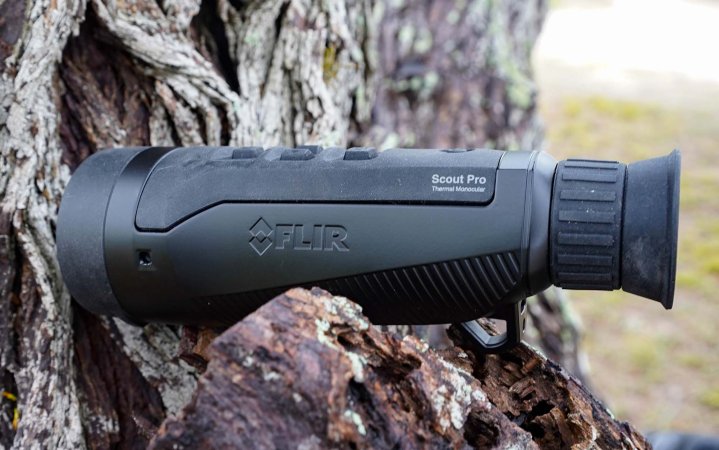
Photo by Scott Einsmann
Buy From Amazon
Buy From Optics Planet
Pros
- Durable polymer armor
- Impressive 32-degree field of view
- Simple menu navigation
- External Wi-Fi connectivity switch
- Fixed focus
- Versatile mid-distance detection device
- Ergonomic and simple 3-button operation
- 2x base magnification, 4x zoom
Cons
- Disappointing run time
- Underwhelming 17-micrometer pixel pitch
- Pedestrian mobile app
- 19mm germanium lens limits performance
Key Features
-
640×480 thermal core -
1024×768 OLED display -
17-micrometer pixel pitch -
-
30Hz frame rate -
500-meter detection range -
16GB on-board image storage -
Internal rechargeable battery -
6-hour run time -
5-year warranty -
Tripod-mountable -
Price:
$2,295
The return of Teledyne FLIR to the consumer market is a happy surprise for those of us who cut our thermal teeth on early versions of the brand’s monoculars. The discontinued FLIR Scout was a handy companion in campsites and for light surveillance work. Equally happily, the new Scout Pro is a much more powerful and versatile unit.
It’s not quite up to snuff with the year’s leading thermal viewers. It doesn’t have the range or hunting-forward features of units from AGM or Nocpix, partly because of its pedestrian resolution and puny thermal lens, but it is bombproof inside its hefty polymer armor, as you’d expect for a monocular configured for law enforcement use. The FLIR has a 2-meter drop protection rating and a 5-year warranty, two years longer than most thermals.
We like the wide field of view that made it a test team favorite for panning large landscapes. The Scout Pro balances nicely in hand, and the three-button operation makes it a fast and efficient viewer. Other nice touches include an external switch that enables Wi-Fi connectivity, threaded tripod adapter, and tack-sharp diopter control.
But the demerits piled up for the Scout Pro. The battery seemed to bleed storage capacity faster than other units, requiring us to keep the FLIR plugged into a power source while we were in the field. The Scout Pro App enables live-streaming and photo/video transfer, but the mobile app is fairly pedestrian. And the fairly limited operating range of the unit along with its 4-color palette and lack of a stadiametric rangefinder is on the lower end of specs for the category.
Lastly, the small 19mm objective lens limits the FLIR’s resolution. We could make out close-in objects fairly well, but the Scout Pro wasn’t useful for detailed work beyond about 200 yards. Compounding the anemic resolution is its 17-micrometer pixel pitch, the lowest of our field. And we thought the $2,295 price was steep for the performance.
If it’s not great for detailed work, the FLIR excels in panning large landscapes, detecting thermal signatures out to a half-mile. But if you want to distinguish identifying details, even inside that range, you’ll probably be a little frustrated with the resolution of the Scout Pro.
Pulsar Merger LRF XT50
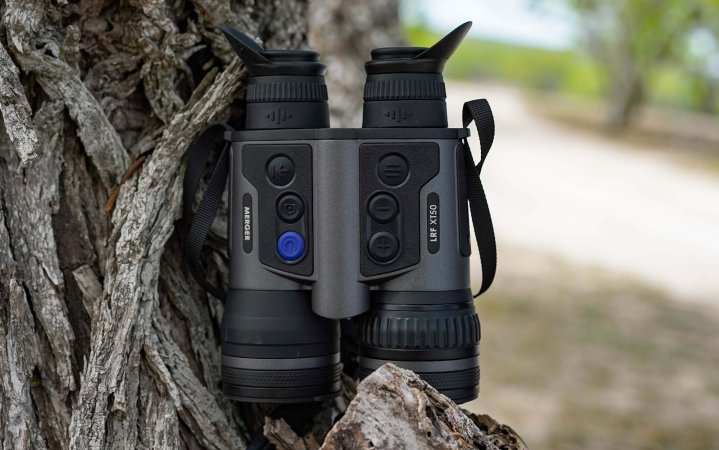
Photo by Scott Einsmann
Buy From Cabela’s
Buy From Midway USA
Pros
- Best-in-class ergonomics
- Auto shutoff extends battery life
- Easily accessible rangefinding mode
- Excellent palette-switching feature
- Tripod adapter
Cons
- Distractingly long refresh rate
- At about $8,000, unattainable price
- Proprietary batteries limit utility
Key Features
-
1280×1024 thermal sensor -
1280×960 AMOLED display -
12-micrometer pixel pitch -
-
-
50Hz frame rate -
2,500-yard detection range -
64GB on-board image storage -
6-hour run time -
Tripod-mountable -
Price:
$8,000
Pulsar has owned the top end of the thermal viewer (and weapon-sight) market, and the high-resolution Merger LRF XT50 is among the brand’s best expression of its talents. But while Pulsar has dominated, other brands like AGM and Nocpix have rivaled the capabilities of its thermal cores and user interface. While the Merger LRF XT50 is an extremely capable viewer, it has company at the super-premium level to competitors that are faster, crisper, and have more intuitive interfaces.
To put a point on it, the Pulsar Merger XT50 has frequent and longish refresh pauses. That’s not a problem in many viewing situations, but if you’re tracking a running coyote or trying to parse the details of a pig in a confusion of heat-retaining tree trunks, the pauses are not only distracting but they can cause you to lose your target in the freeze. It’s important to note that the refresh rate quickens as the Merger XT50 warms up, but it was still more frequent than most other high-end viewers.

The refresh rate aside, the Pulsar is a powerful observation device, and the both-eyes-open operation enables longer viewing sessions and less eye fatigue than monoculars or the other binoculars in our test. The Merger balances and fits the hand well. Once you focus the image and display to your eye, it is easy to use to pan large landscapes. And it has the best laser rangefinder of any of the LRF viewers we tested.
Its focus and overall handling of the magnesium-alloy chassis is refined, without the plasticky feel of most thermals. It has the widest field of view of any of the three thermal binoculars in this year’s test, and it’s powerful. We picked up deer out to about 2,000 yards, beyond the 1,600-yard limit of the laser rangefinder, and the 1280-class sensor delivered detailed textures of targets inside 400 yards. The Pulsar has a rated detection range of 2,515 yards.
Testers who are accustomed to loading their pockets with standard 18650 batteries to power a number of different devices complained about Pulsar’s proprietary batteries. On the other side, the Merger has a power-saving facial-proximity sensor in its eyepiece. The sensor automatically adjusts backlighting to conditions, and powers up as you bring the device to your eye. The feature not only extends battery run time but prevents night-blindness as you deploy the Pulsar.
While the test team concurred that the Merger LRF XT50 is overpriced, Pulsar’s StreamVision 2 app (with cloud storage) is the best in the business, the 1280×960-pixel resolution of its video and photos are remarkably rich in detail, and the binocular is built for the rough conditions of the field. Bottom line: Investment in this high-end binocular should provide years of service and sustained value for those who want to sell or trade for a coming year’s model.
Guide TE 421
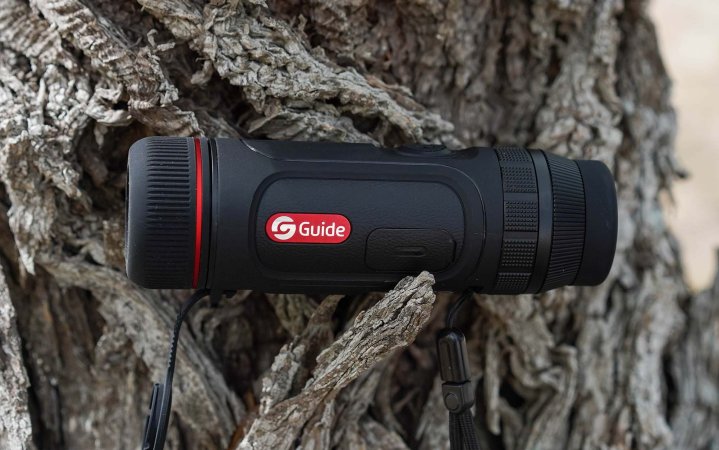
Photo by Scott Einsmann
See It
Pros
- At 5.2 inches long, very compact
- Tripod-mountable
- One-hand operation
- Menu accessed through rotating collar
- 10-year warranty
- Accessible price for portable thermal
Cons
- 1-hour run time limits utility
- Menu-navigation collar turns stiffly
Key Features
-
400×300 thermal core -
800×600-pixel AMOLED display -
12-micrometer pixel pitch -
-
1,400-yard detection range -
7 color palettes -
Price:
$949
This may not be the thermal that serious night hunters reach for, but it’s a thermal for just about everyone else. Compact enough to fit in a pocket, stupid-simple to use, and versatile enough for close-in surveillance and mid-range target ID, it has all the features of units costing three to four times its price.
Those features include image focusing on the objective lens bell, diopter eyepiece focus, seven color palettes, Wi-Fi connectivity to a very good mobile app for image sharing and live-streaming, and smart attributes like a battery-saver mode, refresh countdown clock, picture-in-picture and hot-track modes, and a claimed 1,400-yard detection range. Not bad for a handy thermal that costs under $1,000 and features an impressive 10-year warranty.
Among the best features: single-button operation. The menu is accessed through a rotating color just ahead of the eyepiece focus. It’s a system for thermal virgins or tech-challenged users who struggle with the long- and short-push of multiple function buttons. Simply turn the collar to the function you want, then select with a push of the top button. What could be easier?
There are some limitations to the TE 421. The 1-hour run time is among the shortest in the field, and while the Guide has a tripod adapter, it’s too shallow to be much use with most standard tripod plate studs. The display sits so far inside the housing that viewing can seem like looking down a tube. Its utility is limited to inside 100 yards. Also, we found the navigation collar a little tight, to the degree that it was hard to hold the unit still while riffing between functions.
But, considering those limitations, the Guide TE 421 is a charming, useful, and frankly fun thermal that would be a great entry-level viewer or an extra thermal to have around your house or vehicle.
Armasight Warden
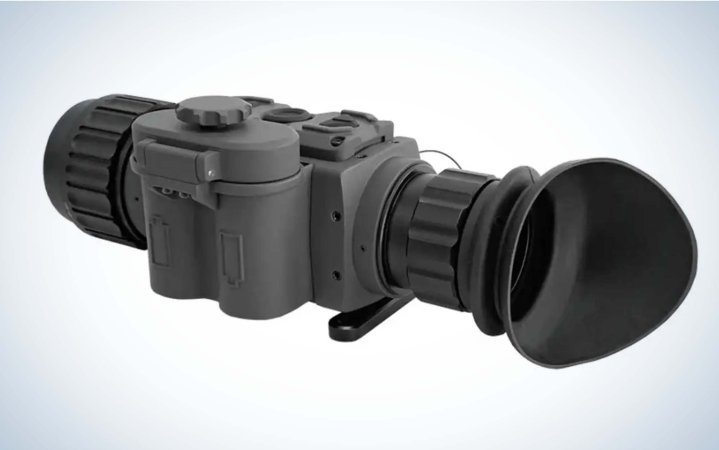
Buy From Optics Planet
Pros
- Wide field of view enables landscape panning
- Durable metal-alloy housing
- 3-button control is fast and intuitive
- CR123 batteries are widely available
- Lightweight and compact
- Integrates with Armasight’s weapon-mounted thermals
Cons
- Images must be transferred via USB cable
- Objective lens focus hard to turn
- 4-hour battery run time limits operation
Key Features
-
640×480 thermal sensor -
1024×768 OLED display resolution -
12-micron pixel pitch -
-
60Hz frame rate -
1,300-meter detection range -
5 color palettes -
On-board image storage -
Runs on standard CR123 batteries -
3-year warranty, with registration -
Price:
$3,499
Along with Trijicon and Teledyne FLIR, Armasight mainly makes thermals for military and law enforcement customers. But unlike its peers, whose mil-spec thermal devices are so overbuilt that most hog and predator hunters can’t afford them, Armasight’s Warden is priced at the upper end of the consumer market, with enough attributes that it’s a good choice for hunters who operate in rugged conditions or who can’t seem to take care of fragile electronics.
The Warden is built around a standard 640×480 core with decent resolution and thermal attributes and enough reach to be useful for most hunters. The company claims a 1,300-meter range, but the best we could do with human- and deer-sized targets was about 900 meters, or close to 1,000 yards. Testers have mixed feelings about stadiametric rangers, available on most thermals without built-in laser rangefinders, but without one it’s hard to know if that 800-yard target is an Angus or an antelope.
We’ve also been conditioned by most Asian-sourced thermals to expect a mobile app that’s Bluetooth-connected to the device, enabling easy transfer of images and video clips, and even streaming images to a phone. The Warden doesn’t have any of that. Instead, images are stored on the device and must be transferred via a USB cable. It’s not a deal-breaker, by any means, but it does limit sharing.
There’s no tripod-mounting adapter, but the Warden does come with a Pic rail for mounting options and a useful lanyard for cross-shoulder carry. Operationally there are some funky features to overcome, including an over-stiff focus ring on the 35mm objective lens, and while the accordioning eyecup is a great feature it doesn’t rotate independent of the diopter focus, which means it often gets in the way when users switch eyes. Left-handed testers complained their hands didn’t comfortably fit around the protruding metal battery case.
Those are admittedly small bugs. We like the wide 22-degree field of view for panning landscapes, and the 3-button operation is fast and intuitive. When used in conjunction with Armasight’s 640-series Commander thermal scope and Operator clip-on sight, images, reticles, and operations are nicely synched. When used on its own, the Warden is a versatile, rugged, and simple thermal monocular.
ATN BlazeHunter 650 LRF
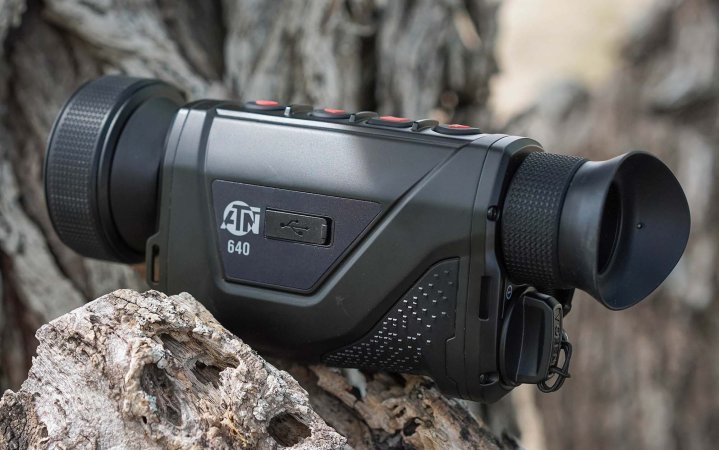
Photo by Scott Einsmann
See It
Pros
- 50mm germanium lens
- Impressive run time
- Runs on standard 18650 batteries
- 6 color palettes
- Tripod-mountable
- Ergonomic and hand-filling
- Intuitive 3-button operation
- 2x base magnification, 4x zoom
Cons
- Ghosty image
- Frequent refresh
- Rangefinder yardage is hard to read
Key Features
-
640×512 thermal core -
1440×1080 OLED display -
12-micron pixel pitch -
-
50Hz frame rate -
2,600-yard detection range -
1,000-yard laser rangefinder -
14-hour run time -
3-year warranty -
Price:
$3,695
On paper, this is the platonic ideal of a thermal viewer. It has a big 50mm germanium lens, a compact and extremely handy one-hand operation and useful hand strap, 3.5x base magnification, and all the bells and whistles (six color palettes, Wi-Fi connectivity to mobile app, a 1,000-yard laser rangefinder, and a decent 640-class thermal core) you’d expect of a mid-priced monocular.
While the BlazeHunter works as advertised, its image isn’t as clear or crisp as its peers, it exhibited distracting lag, or refresh, and testers complained of eye-aching night blindness after extended viewing sessions.
That user experience may be a function of the power and reach of the BlazeHunter 650. It has a remarkable 2,600-yard detection range, and while we pegged the real-world distance to about 1,500 yards, that’s still a lot of yardage. Similarly, we hit the limit of the claimed 1,000-yard rangefinder at about 700 yards. Again, that’s plenty of reach for most users, and testers complained most about image degradation and eye fatigue as we reached for distant targets, zooming out to 8x.
When we kept the ATN at lower magnification and modest distances, our complaints with the image were replaced with accolades.

“Decent detail inside 200 yards,” noted tester Scott Einsmann. “I recorded a video of deer at 100 yards and could very clearly identify it and also see hair and anatomical details.”
The best use-case for the BlazeHunter is as the wingman for a hunter on a dedicated thermal scope. Pan landscapes at lower power, detect and identify targets, and then range them. The 640-class monocular can handle that basic chore with ease, especially inside the distances of most real-world predator and hog hunting.
At just under $3,700, it’s a fairly pricey unit, but ATN offers the BlazeHunter in a 384×288 version with 4x base magnification for $2,195 or a 640-class unit with 2.5x base-mag for $3,195. These units have 1,800-yard and 2,000-yard range, respectively, and may be a better fit for the platform.
ATN Blaze Trek 325
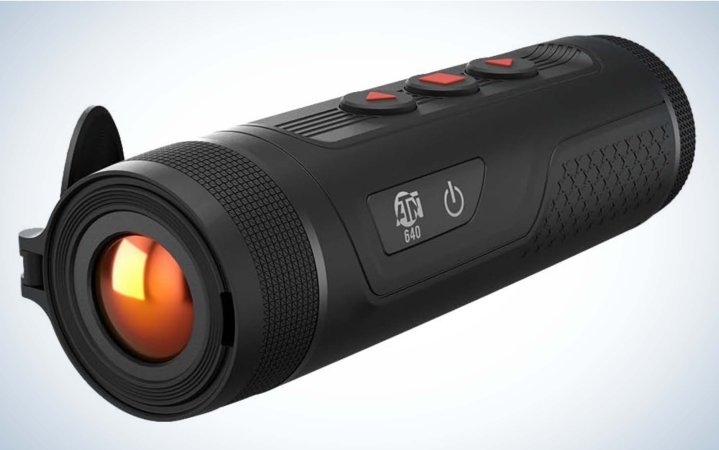
See It
Pros
- Compact: 6.2 inches long and 9 ounces
- 8-hour run time
- 5 color palettes
- Simple menu navigation
- Fairly large (25mm) objective lens for platform
- Ergonomic and simple 3-button operation
- 2.7x base magnification, 8x zoom
Cons
- So light that it’s hard to hold still
- At about $1,400, fairly pricey
Key Features
-
384×288 thermal core -
800×600 OLED display -
12-micron pixel pitch -
-
50Hz frame rate -
1,300-yard detection range -
16GB on-board image storage -
Internal rechargeable battery -
3-year warranty -
Tripod-mountable -
Price:
$1,495
One of the genius features of ATN’s thermals is that most models are available in a wide range of configurations. Prospective buyers can match the resolution, performance, and price of units to their budget. We tested the lower-end BlazeTrek, but a higher-performing 640×512 micron unit is available for about $2,200, or about double the price of the 384×288 unit.
That price differential tells you all you need to know about thermal resolution, in general. You can expect to pay approximately double for every doubling in the resolution of the thermal core.
But ATN has another benefit for would-be buyers. They can try out the units themselves, hold them in hand, and compare and contrast their capabilities at one of the company’s stores in major Texas cities, Atlanta, and Chicago. That’s a helluva benefit, since most thermal customers buy online and have to go on specs, YouTube videos, and the (sometimes compromised) impressions of social media influencers to make buying decisions.
This little monocular has so much packed into its 9-ounce, 6.2-inch frame. It has a stadiametric rangefinder, hot-point tracking, Wi-Fi, video and still image capture, and a sensitive core. Too many features, noted the test team. It doesn’t really need the rangefinder, and the 1,300-yard detection range is just too ambitious for a tiny viewer. Our conclusion: operate this at whitetail ranges, inside about 200 yards, and you’ll be happier with its abundant talents. Beyond that range images get flimsy and ghosty and users get frustrated with its shortcomings.
Pulsar Telos LRF XL50
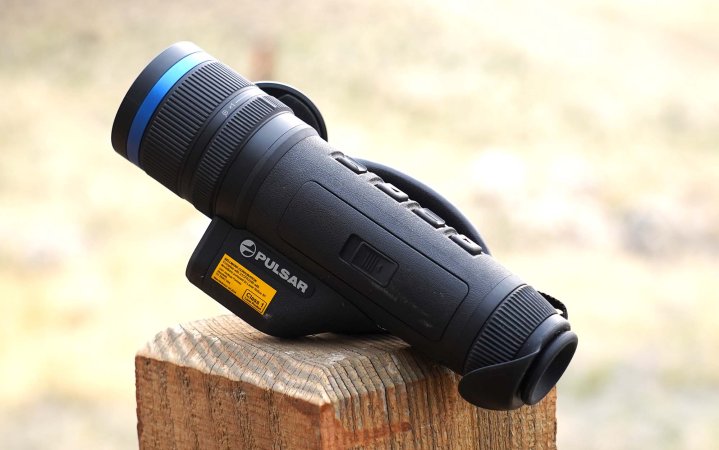
Photo by Andrew McKean
See It
Key Features
-
2,300-yard detection range of deer-sized target -
1,000-yard laser rangefinder -
2.5-20x magnification -
Photo and video recording and WiFi image transmission -
1024×768 @12-micron sensor resolution -
1024×768-pixel display resolution
This flashlight-sized thermal is easy to use, renders excellent images, is built double-tough, and stands out as one of the first of the industry’s high-definition thermals. With a 1024×768-micron sensor, it’s one of the most advanced thermals on the market, and thanks to a fast operating system and one of the best mobile apps in the business, it’s a cinch to operate the thermal from your phone and to store and share both videos and still images.
The unit’s three-button operation is fast and intuitive, flattening the learning curve and making nighttime operation easy, even for hunters who haven’t gotten used to navigating a thermal based on feel and memory.

After handling dozens of thermals in the course of our testing, I can say that most feel flimsy and made mainly of fragile plastic. The Telos is constructed out of rubber-armored reinforced plastic, so unlike a magnesium-frame binocular or aluminum-tube riflescope, it will break if abused, but it has a solid-state feel, and its internal operation is equally robust and positive.
It’s a thinly concealed trade secret that some thermal devices attempt to amplify low sensor resolution with relatively higher display resolution. Imagine an image the size of a postage stamp. The only way to increase its size is to magnify the already tiny image, but when you increase an indistinct image, you only magnify its deficiencies. That’s essentially what happens when display resolution exceeds sensor resolution in most thermals; the high-def displays simply make fuzzy images larger. The Pulsar Telos, with a display resolution the same size as its sensor resolution, delivers sharper, more robust images than its peers as a function of its more advanced technology.
But there’s a price for that performance. This thermal monocular costs over $5,000, putting it out of reach of many hunters. While we’re covering its shortcomings, we should note that the manual zoom — users twist a knurled ring just inside the objective focus ring — is easy to use, but it’s so tight that as users zoom up or down in magnification, it’s hard to keep the image centered. I’d like to see a tripod mount on the unit; it would be a way to stabilize the image and add to its prodigious utility.
Lastly, the laser rangefinder is a key feature, but you have to riff through a number of menu items to simply activate the stadiametric rangefinder. It’s tedious and time-consuming when precious minutes count.
Merits include the excellent StreamVision 2 app that connects all Pulsar units with mobile phones. The interface is clear and easy to use, and users can easily use their phones as device displays, activating cameras, switching palettes, and boosting image sensitivity. Unlike many thermal units, which have only 2.4-GHz Wi-Fi transmission, the Pulsar adds a 5-GHz bandwidth to broaden the connection between unit and phone and make image transfer and wireless communications even more frictionless. The device stores a healthy 64 GB of memory on-board, and the app easily transfers images from the thermal to a mobile device when you’re back from the field.
Of all the thermal viewers that we tested, this is the one that we reached for after our evaluations, when it was time to simply enjoy the talents of a thermal without fuss or frustration. If cost is no option, then this is hands-down the unit for you – and for us. And if you’re a budget shopper, consider that this overbuilt, super-resolution thermal is where most of its peers will be two and three years from now.
Armasight Sidekick 640
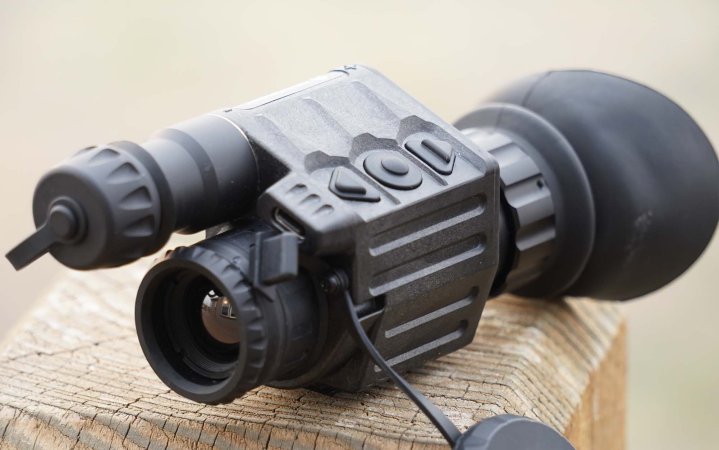
Photo by Andrew McKean
See It
Key Features
-
Effective Ranges on Human-Sized Target:
709-meter detection, 177-meter recognition, 111-meter identification range -
1-4-times digital zoom -
4-hour on-board video storage -
Helmet-mountable -
640×480 12-micron sensor resolution -
1024×768-pixel display resolution
The smallest full-featured 640-class thermal monocular on the market, this little powerhouse goes anywhere, and can be used as either a hand-held or helmet-mounted device.
The Sidekick weighs just over half a pound, but its image and sensitivity matches that of monoculars three times its heft and ten times its dimensions. Its diminutive size does have some drawbacks, including relatively short battery life, no Wi-Fi connectivity to an app, and limited detection range.
The full value proposition of the little Sidekick 640 is demonstrated when mounted to a helmet. The idea is that a solo hog or coyote hunter can run the Sidekick as a monocular on their weak side, picking up incoming animals with its wide field of view and very good display resolution. The hunter can then get behind a thermal-mounted rifle to complete the shot. That sort of transitional deployment is hard to achieve with most hand-held monoculars.
The small size and integration with night vision and other helmet-mounted devices hint at the origins and intention of the Armasight: It’s really a military-grade thermal. That doesn’t mean it doesn’t have abundant civilian application, it’s just that you’ll get the best out of the unit if you run it in tandem with other operator-centric devices.
The guts of the Sidekick are the thermal core, standard sensor, and high-resolution displays you’ll find in most of the thermal devices in our test. We’d like to see a Wi-Fi or Bluetooth transmitter on board, in order to wirelessly transfer images and videos from the unit to a phone and to enable remote operation. But the three-button navigation is simple to use, and the tactile feel of each button enables smooth, fast operation, even when the Sidekick is mounted on a helmet. If you run this unit in cold weather, or for long hunting sessions, you’ll want to bring extra CR123 batteries or use the Armasight battery extender. The run time of the standard batteries is a little over an hour.
This isn’t the thermal for everyone, but for those who hunt by themselves and who are comfortable with a head-mounted viewer, it’s a military-grade unit that’s fully at home in the coyote hills and hog fields.
Pulsar Axion 2 XQ35 Pro LRF
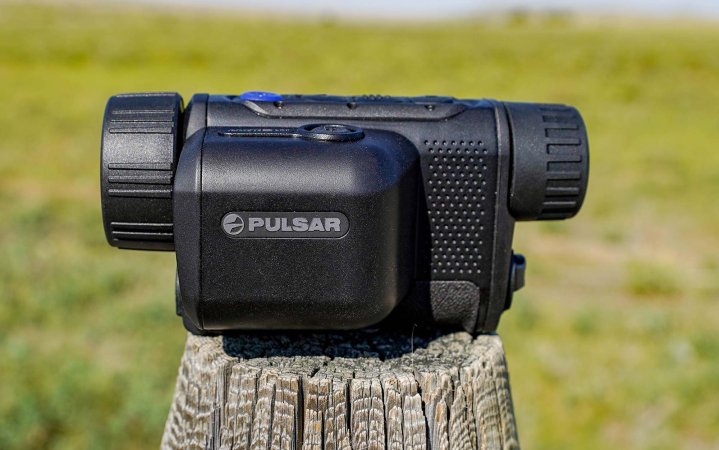
Photo by Scott Einsmann
See It
Key Features
-
1,300-meter detection range -
1,000-meter laser rangefinder -
2-8x magnification -
Photo and video recording and WiFi image transmission -
8 color palettes -
384×288 sensor resolution -
640×400-pixel display resolution
If you are driven to fist-clenching rage by Pulsar’s cutsie and confusing nomenclature, in which similar-looking thermals share nearly identical names, but have wildly different operating features and prices, then join me in complaining to the company. Or to the heavens, at least. Case in point is this very capable, very appealingly priced hand-held thermal monocular, the Axion 2 XQ35 Pro LRF. It costs about $1,800, one of the more price-accessible thermals on the market, priced low mainly because it has a small and fuzzy sensor.
The nearly identical Axion 2 XG35 LRF costs almost twice as much, right at $3,000. It looks and operates nearly the same as the XQ35, but it has a high-resolution sensor that provides about three times the resolution. Hence, the heftier price.
But a casual shopper sees mainly the price differential and the nearly identical name, not the delta in performance.
We’ll talk about those performance shortcomings in a bit, but first I want to make the case that the XQ35 is a very good choice for a first thermal for a casual hunter. First, it shares a robust and field-worthy chassis with the XG35. Both are built on magnesium alloy, a rarity in the plasticky world of thermals. Second, the 35mm objective lens they share is sized about right for most purposes. Internally, the Pulsars share an operating system and rechargeable battery type. And both communicate through Pulsar’s very good StreamVision 2 app, which capably operates the unit remotely and accepts wirelessly transmitted videos and photos. Lastly, the laser rangefinder is the same in both units, and actually not very accurate.
The biggest difference between the two — apparently a $1,200 difference — is the thermal sensor. The more expensive XG35 has a 640×480-pixel sensor with 12-micron pitch. The budget XQ35 has a 384×288-pixel sensor with 17-micron pitch. The 640-class sensor is the industry standard; the 384 sensor means that images from the cheaper Pulsar will be fuzzier.
The differential in resolution is further exaggerated by the fineness of the displays. The XQ35 has a 640×400-pixel display, while the XG35 has a high-def 1024×768 screen.
Is that level of sensitivity and resolution worth $1,200 to you? Only you can answer that question, but the difference is observable in image capture. Photos and video from the XQ35 will be grainier and less capable of being enlarged than the relatively more detailed and crisper images from the XG35.
If you are simply using your thermal viewer to detect targets at night, you probably won’t notice much difference. But if you are the sort of thermal user who wants to capture and share videos from your outings, you might want to opt for the higher-resolution monocular.
Bottom-line: If you have the funds to spring for the more expensive Axion 2 XG35 LRF, do it. No one in the history of cameras or optics has regretted having more resolution. But if you can only afford the Axion 2 XQ35 LRF, get to learn its operating features and its capabilities, and then apply your knowledge to buying a more sophisticated thermal down the road, as these units become more affordable, and as your own disposable income increases.
Pulsar Merger Duo NXP50
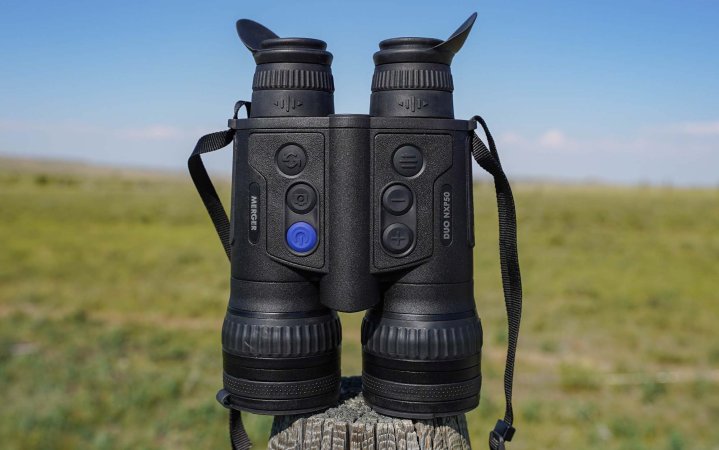
Photo by Scott Einsmann
See It
Key Features
-
1,969-yard detection range -
1,100-yard stadiametric rangefinder -
3-24x magnification -
Photo and video recording and WiFi image transmission -
Tripod-mountable -
640×480- microbolometer sensor resolution -
1280×960-pixel display resolution
At just over $6,000, the Pulsar Merger Duo is nearly the priciest thermal viewer in our collection. It’s certainly the most versatile.
The Duo in its name implies its dual thermal-night-vision capability. Simply press a button and the Pulsar switches from standard thermal viewer to night-vision optic. The dual function enables the unit to detect heat signatures in complete darkness (the thermal side of the house) or to amplify ambient light to highlight visible objects (that’s the night-vision side). An auxiliary LED illuminator, housed in the belly of the binocular, provides additional light for night-vision visibility.

The Merger Duo is like other thermal binoculars in that it’s not actually a binocular. Sure, it has two barrels, but only one has the heat-detecting element germanium in its objective lens. The other lens is for observation only, but also provides binocular vision for the night-vision function.
The heart of the Pulsar is its 640×480 microbolometer sensor that is enhanced by a high-def 1280×960-pixel display. This is the same imaging engine found in the XG35 monocular that we discussed in the review of Pulsar’s Axion 2 XQ35 Pro LRF monocular. The functionality of the Merger Duo is identical to the higher-end monocular. Both are supported by the excellent Stream Vision 2 app that allows user to store and share video and images captured by the devices and also operate some functionality like changing color palettes and even firing the device’s camera.
Like the monocular, the Merger Duo binocular features a laser rangefinder. Unlike the monocular, where the rangefinder is essentially bolted on the chassis, the rangefinder is built in to the binocular’s substantial chassis. It’s what’s called a stadiametric rangefinder, which uses a bracketing line to provide approximate distance to objects of a known size. It’s not as fast or as precise as a daylight laser rangefinder, but it’s a very useful feature to determine, for instance, if a target is a whitetail fawn or a market-ready Hereford.
In the field, I struggled with getting images tack-sharp. The Pulsar has four focus wheels, one on each eyepiece and one on each objective lens, and focusing requires fine-tuning each of these controls. But even when the image appeared focused to my eye, I noted that the images I captured in those moments are noticeably fuzzy.
But that’s the extent of my criticisms of this fast, useful, and powerful unit. The monochromatic night-vision feature is extremely useful, especially for moving through dark landscapes. The NV capability allowed me to walk into a hunting area without using a game-spooking headlamp. Once in place, I switched off the night vision and relied on the thermal feature to reveal coyotes.
The image capture is easy and simple, and transferring images and videos to my phone through the excellent Stream Vision 2 is frictionless. The rechargeable battery has a 7-hour run time, depending on ambient temperatures, and the refresh rate and overall image resolution is as good or better than other upper-end thermals in our class.
Is that amount of performance worth $6,000? Hard to say, but the Pulsar is well-built and the brand has so much experience with thermals that it’s hardly a risky buy. If you are interested in a high-end thermal combined with pretty good night-vision capability, then this combined unit starts to look like a bargain.
How We Tested the Best Thermal Monoculars and Binoculars
We tested this year’s class of thermals in the places and style that most American hunters use them: in Texas hunting coyotes, bobcats, and wild hogs.
We based our test out of a sprawling ranch in South Texas’s brush country, where we had thousands of acres of coyote and bobcat hunting out the back door. We also had access to a shooting range with steel targets out to a mile.
We strapped all thermal weapon sights onto either Horizon Firearms bolt guns or ARs chambered in 22 Creedmoor and zeroed the thermals at the range in both daylight and after dark. We used the thermal viewers to assess hits, just as a range spotter might do with daylight optics. And we used the stationary targets as the basis for assessing thermal image, sensitivity, focus, and operating range.
But the bulk of our testing was in the field. Test team member, competitive coyote hunter, and captain of “Team Dead On,” David Stroud, provided his high-rack rig with three swiveling shooting tables. While Stroud drove, the rest of the team rotated through sessions on the high rack and with various thermal sights and viewers. In quiet moments between calling sessions, we cycled through thermals’ menus, practiced navigating their buttons and features in the dark, and assessed image quality, various features like rangefinders and color palettes, and recorded videos and photos through the devices.
And we killed coyotes and bobcats, enough to confirm the talents of many of the submissions in real-world conditions. Our plan was to take the collection of thermals to a neighboring ranch for a night of pig hunting, but while we were in South Texas, a monsoonal rainstorm broke the region’s drought, and we were washed out of pig hunting. But Stroud later took many of the thermals to a hog lease, where he finished evaluations and content collection.
In daylight, we further evaluated the units, rating them on ease of use, connectivity to a mobile app, versatility for a wide range of uses, thermal features, image resolution and overall image quality, and durability. And we assessed their value, asking of each submission: how much performance do you get for the money. This particular category, considering thermals can cost several thousand dollars, is among testers’ (and buyers’) most important considerations.
The unit with the highest overall score wins our Editor’s Choice as the best submission in the category. The thermal with the highest Price/Value score wins our Great Buy award.
The Outdoor Life Thermal Test Team
This year’s Outdoor Life thermal test team includes a pair of Texans who handle more thermals in a month than most of us do in a year and three Outdoor Life editors who evaluate gear with a combination of objectivity and close attention to detail and value to readers.
Texan David Stroud actively participates in the growing competitive coyote circuit, hunting all night across Texas at least a couple weekends a month and using a wide variety of thermal viewers and weapon-mounted sights in his pursuit of fur and prize money.
Derrick Ratliff is the founder and president of Horizon Firearms in Bryan, Texas. Ratliff was an early adopter and manufacturer of the 22 Creedmoor, a round that’s become a darling of night hunters for its flat trajectory, mild recoil, and hard-hitting performance on predators and hogs. We ran Horizon’s bolt guns chambered in 22 Creed, fueled by Hornady’s 80-grain ELD-X ammunition.
Alex Robinson is Outdoor Life’s editor in chief and frequent member of OL’s gun and optics tests. He’s an avid deer, turkey, and waterfowl hunter and is relatively new to hunting with thermals.
Scott Einsmann is Outdoor Life’s gear editor, and oversees all of OL’s flagship gear tests. As the youngest member of the test, he’s also a digital native, an important consideration for navigating thermal devices.
Andrew McKean is Outdoor Life’s optics editor and designed our test methodology as well as handling most of the testing logistics.
How to Choose the Best Thermal Monocular
After you’ve talked yourself into needing a thermal monocular, your next questions should be about capability and cost.
Capability
Do you need to share videos with your buddies? Then make sure to pick a viewer with easy image sharing, and the best of the bunch have mobile apps that enable sharing. Will you be using it in sub-zero conditions? If so, consider battery run time. And you should critically assess your tech skills, because most of these units require a fair amount of digital savvy to get up and running, and then to get the most out of their capabilities.
All these thermal units have different viewing modes. The industry standard has become some variation of these palettes: white hot, black hot, rainbow, and red hot. And most devices have some sort of on-board recording feature, but there’s a wide range of capabilities, including built-in Wi-Fi and Bluetooth that allow users to share images.
As you’re looking over the field, also take note of the imaging capabilities of various devices. Some have extremely rich resolution, thanks to large objective lenses that gather more detail. Others deliver sharp renditions of the image because of high-resolution screens, and still others use more or fewer pixels to influence the image. The best have high scores in each of these three categories; others might compensate for poor resolution with a sharp screen.
Be aware of the limitations of the monoculars I’ve reviwed. As a class, they are designed to identify thermal variations (the night-vision and infrared devices amplify ambient light). They’re not designed as targeting aids or riflescopes – we’ll cover that category of thermals in another post. This is an important consideration, because if you’re looking for a thermal to get you started in nighttime hog or predator hunting, then you’re probably better off investing in a thermal scope or clip on.
Cost
Next, how much are you willing to spend on a thermal viewer? Products in this roundup range in price from about $400 up to well over $3,500. Because entry-level products generally tether to your phone, their versatility is limited. But the higher-end thermal viewers offer so much resolution and imaging talent that unless you’re using the devices frequently, you may be paying for more capability than you need.
The thermal or night-vision optic that’s right for you will depend on how you’ll use it. If you simply want to know what goes bump in the night, a simple hand-held thermal is a good choice for detection, and is by far the most cost-effective category of this class of optics. Most have on-board recording of both video and still images, various display modes, and are housed in compact, ergonomic bodies. Expect to pay anywhere from $650 to $2,500 for these units.
The least expensive units are those that connect to smart phones. Because of their diminutive size and modest on-board controls, they have limited resolution, but they can cost anywhere from $400 to about $800.
Of course if you want to clearly identify objects at long distances, record HD video, and range targets, expect to pay well over $3,000. If you also want a monocular that works as a clip-on weapon sight, with the same capability, you can expect to pay $6,000 to $17,000.
Why Are Thermal Monoculars so Expensive?
In terms of cost, you’re mainly paying for two attributes. For thermal units, the first is the heat-sensing lens. It’s made of a special crystal called germanium that, when shaped into a lens, blocks extraneous wavelengths and boosts temperature differentials. And you’re paying for image processing speed and resolution. An expensive thermal allows you to clearly identify animals and an inexpensive one will show you animal-shaped blobs. It’s like the difference between the first cellphone cameras and the latest iPhone model.
Final Thoughts on the Best Thermal Monoculars
A thermal monocular, especially one with a laser rangefinder, adds a lot of capability to night hunting. You can safely scan the surrounding area to look for game, identify it, and get a range before you ever pick up your rifle. The new helmet mounted options mean you can navigate with thermal and night vision to get the best of both worlds. The hardest part is choosing the right product and price point for your needs. As of right now, there aren’t many bargains when it comes to high-end thermals. You get what you pay for, but that doesn’t mean lower-priced options don’t have their place. Even a cheap thermal is excellent for detecting animals within 100 yards and if that’s all you need, you can save a few grand.
Read the full article here



